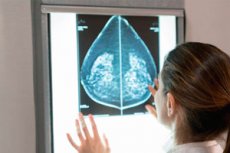Nye publikasjoner
Studie finner økt risiko for sekundær kreft hos brystkreftoverlevere
Sist anmeldt: 02.07.2025

Alt iLive-innhold blir gjennomgått med medisin eller faktisk kontrollert for å sikre så mye faktuell nøyaktighet som mulig.
Vi har strenge retningslinjer for innkjøp og kun kobling til anerkjente medieområder, akademiske forskningsinstitusjoner og, når det er mulig, medisinsk peer-evaluerte studier. Merk at tallene i parenteser ([1], [2], etc.) er klikkbare koblinger til disse studiene.
Hvis du føler at noe av innholdet vårt er unøyaktig, utdatert eller ellers tvilsomt, velg det og trykk Ctrl + Enter.

Brystkreftoverlevende har betydelig høyere risiko for å utvikle sekundære kreftformer, inkludert livmorkreft og eggstokkreft hos kvinner og prostatakreft hos menn, ifølge en ny studie basert på data fra nesten 600 000 pasienter i England.
For første gang fant studien at risikoen var høyere blant personer som bor i områder med lav sosioøkonomisk status.
Brystkreft er den vanligste kreftformen. Det er omtrent 2,3 millioner tilfeller av brystkreft på verdensbasis hvert år, hvorav de aller fleste (over 99 %) forekommer hos kvinner. Forbedringer i tidlig oppdagelse og behandling har ført til en økning i femårsoverlevelse, og nådde 87 % i England i 2017.
Brystkreftoverlevende har risiko for å utvikle andre primære svulster, men den nøyaktige omfanget av denne risikoen har vært uklar. Tidligere publiserte studier har antydet at kvinnelige og mannlige brystkreftoverlevende har henholdsvis 24 % og 27 % høyere sjanse for å utvikle en ikke-brystrelatert andre primære svulst sammenlignet med den generelle befolkningen. Det har også blitt antydet at risikoen for å utvikle andre svulster avhenger av alderen brystkreft diagnostiseres i.
For å få mer nøyaktige estimater analyserte et team av forskere fra University of Cambridge data fra mer enn 580 000 kvinner og mer enn 3500 menn som overlevde brystkreft og som ble diagnostisert mellom 1995 og 2019. Resultatene av analysen deres er publisert i tidsskriftet The Lancet Regional Health-Europe.
Studiens førsteforfatter, Isac Allen, fra Institutt for folkehelse og primærhelsetjeneste ved Universitetet i Cambridge, sa: «Det er viktig å forstå i hvilken grad det å ha én type kreft øker risikoen for å utvikle en annen krefttype et annet sted. Kvinner og menn som overlevde brystkreft hadde økt risiko for å utvikle flere sekundære svulster. Denne kunnskapen kan være nyttig i diskusjoner med legene deres om overvåking av tegn på mulige nye svulster.»
Forskerne fant en betydelig økning i risikoen for å utvikle kreft i det kontralaterale (dvs. upåvirkede) brystet, samt livmorkreft hos kvinner og prostatakreft hos menn. Kvinner som overlevde brystkreft hadde dobbelt så høy risiko for å utvikle kontralateral brystkreft sammenlignet med den generelle befolkningen, samt en 87 % høyere risiko for livmorkreft, en 58 % høyere risiko for myelogen leukemi og en 25 % høyere risiko for eggstokkreft.
Alder ved diagnose spilte også en rolle. Kvinner diagnostisert med brystkreft før 50 år hadde 86 % høyere risiko for å utvikle en andre primærkreft sammenlignet med den generelle befolkningen i samme alder, mens kvinner diagnostisert etter 50 år hadde 17 % høyere risiko. En mulig forklaring er at flere yngre brystkreftoverlevere kan ha arvet genetiske endringer som øker risikoen for å utvikle flere kreftformer. For eksempel har kvinner med arvelige endringer i BRCA1- og BRCA2-genene økt risiko for å utvikle kontralateral brystkreft, samt eggstokkreft og kreft i bukspyttkjertelen.
Kvinner fra de mest sosioøkonomisk vanskeligstilte bakgrunnene hadde 35 % høyere risiko for å utvikle sekundære primære svulster sammenlignet med kvinner fra de minst vanskeligstilte bakgrunnene. Disse forskjellene ble hovedsakelig forklart av risikoer som ikke er relatert til brystkreft, spesielt kreft i lunge, nyre, hode og nakke, blære, spiserør og mage. Dette kan skyldes at røyking, fedme og alkoholforbruk – etablerte risikofaktorer for disse kreftformene – er vanligere blant mer vanskeligstilte grupper.
Allen, doktorgradsstudent Claire Hall, la til: «Dette er ytterligere bevis på ulikhetene i helsevesenet som mennesker fra mer vanskeligstilte bakgrunner står overfor. Vi må forstå fullt ut hvorfor de har høyere risiko for å utvikle sekundære svulster, slik at vi kan gripe inn for å redusere denne risikoen.»
Mannlige brystkreftoverlevere hadde en 55 ganger økt risiko for å utvikle kontralateral brystkreft sammenlignet med den generelle mannlige befolkningen, selv om forskerne understreker at den individuelle risikoen fortsatt er lav. For eksempel, av hver 100 menn som fikk diagnosen brystkreft i en alder av 50 år eller eldre, utviklet omtrent tre kontralateral brystkreft innen 25 år. Mannlige brystkreftoverlevere hadde også en 58 % økt risiko for å utvikle prostatakreft sammenlignet med den generelle mannlige befolkningen.
Professor Antonis Antoniou, fra Institutt for folkehelse og primærhelsetjeneste ved Universitetet i Cambridge, seniorforfatter av studien, sa: «Dette er den største studien hittil som ser på risikoen for å utvikle andre svulster hos brystkreftoverlevende. Vi var i stand til å gjennomføre den og få mer nøyaktige estimater på grunn av de fremragende datasettene som er tilgjengelige for forskere gjennom NHS.»
Katrina Brown, seniorsjef for kreftinformasjon i Cancer Research UK, sa: «Denne studien viser at risikoen for å utvikle andre primære svulster er høyere hos personer som har hatt brystkreft, og at denne risikoen kan variere avhengig av en persons sosioøkonomiske status. Men mer forskning er nødvendig for å forstå hva som forårsaker denne forskjellen og hvordan disse ulikhetene i helsevesenet kan håndteres.»
